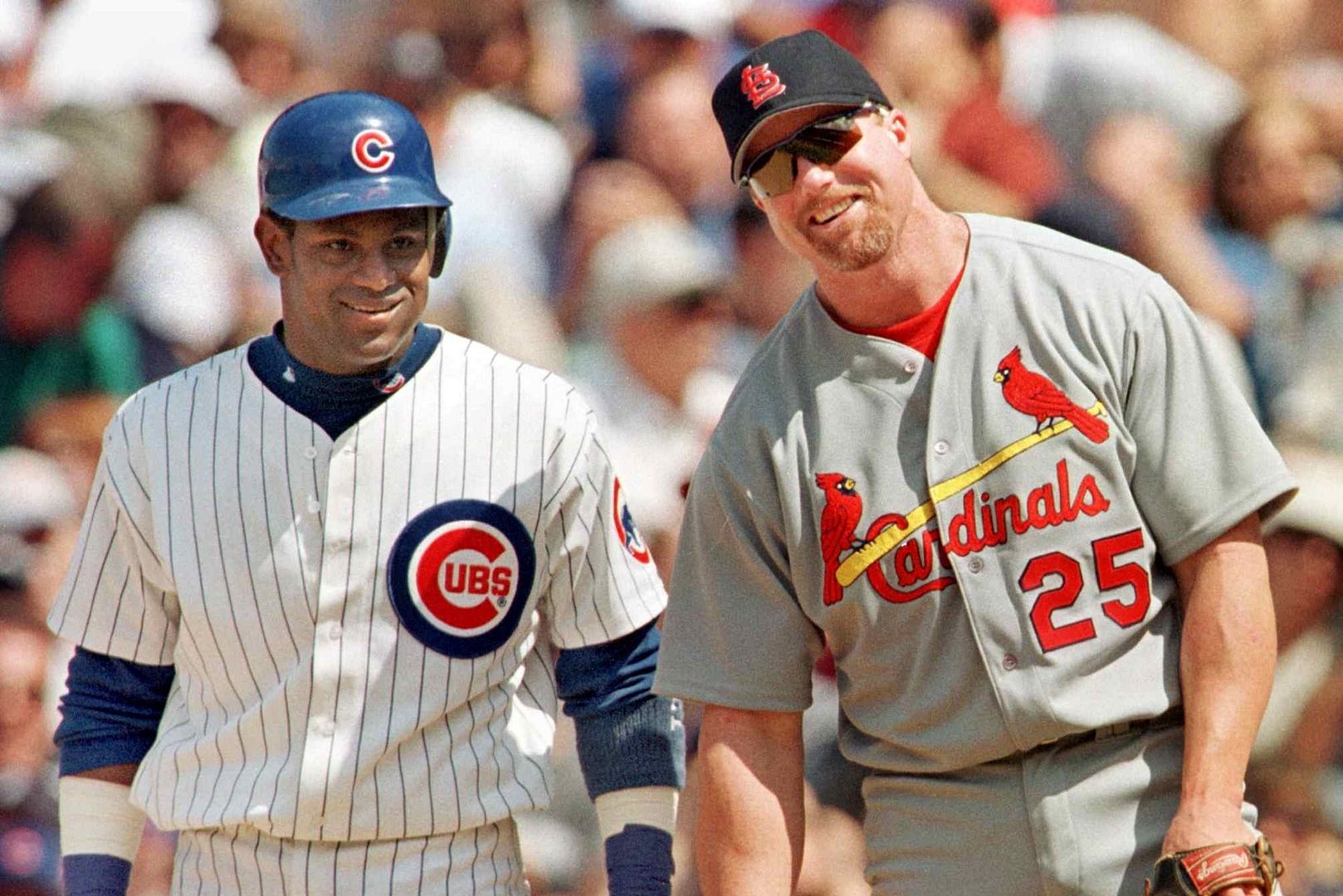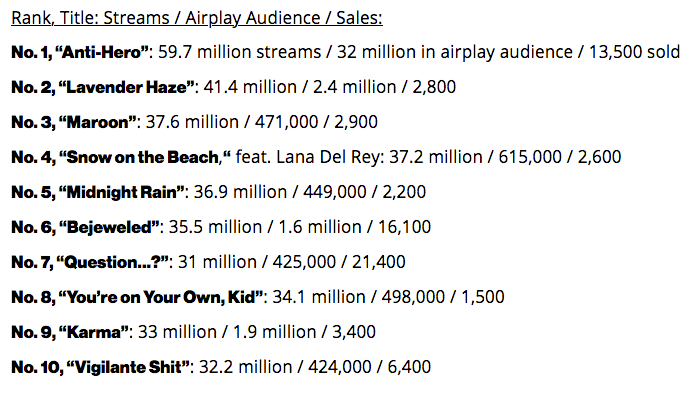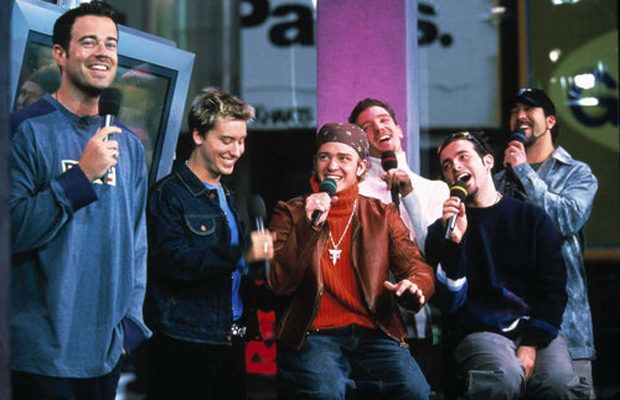Pop Shots – How Streaming & Billboard Have Created Mainstream Music’s Steroid Era

Welcome to your weekly dose of pop world musings. Covering all things pop culture, after seeing Taylor Swift songs populate the entire top ten of the Billboard Hot 100, this week Pop Shots is going to take a look at what I’m calling the steroid era of mainstream music, how we got here, and what achievements like Swift’s really mean.
For those unaware, the steroid era was a time in baseball when home run records were being demolished, as Mark McGwire, and Sammy Sosa didn’t just chase history, they erased history. Barry Bonds then erased both of them, and Hank Aaron, from the record books. The thing was – all those record breakers were later alleged to be using performance enhancing drugs, thus giving birth to the phrase Steroid Era.

Many still regarded Roger Maris’ 61 as the single season home run record despite Bonds having hit 73 in a season. This is why Aaron Judge’s 62 this year was so special. Similarly, many fans also still consider Aaron’s 755 career home runs as the number to beat, even though Bonds finished up with 762.
What does this have to do with mainstream music, and Taylor Swift? Glad you asked.
First off, what Taylor Swift did was impressive, becoming the first artist ever to have all of the top ten songs in a single week when she released her latest album, Midnights. That said, much like Barry Bonds’ records, it comes with an asterisk, as it’s a record that only happened because of Billboard’s decision to include streaming in their Hot 100 rankings, and, even more importantly, the way in which they weight streaming. Combined, these are the steroids fueling the records being achieved in this, mainstream music’s steroid era.
Back in the dark ages, in order to have a song chart on the Hot 100 it had to be released as a single that was available for sale. This changed at the tail end of the ‘90s, as record labels were releasing songs to radio that were only available if people bought an artist’s album, and without these massively popular songs – like No Doubt’s “Don’t Speak,” and Natalie Imbruglia’s cover of “Torn” – the Hot 100 was looking like a woefully inaccurate assessment of what’s “hot.”

In 2007 Billboard began incorporating streaming into how they rank songs on the Hot 100. This meant that X amount of streams would count as a sale (I’m using X because Billboard has made adjustments to this over the years). Did it make sense for Billboard to include the current way people are consuming music? Absolutely. Are they doing this in a way that accurately mimics what would have been sales? I would argue the answer to that is absolutely not.
Let’s take a look at the numbers for the all-Taylor Swift top ten.

We see a lot of streams, but only one song received a huge amount of radio spins – “Anti-Hero” reaching 32 million in “airplay audience” – and just three others cracked 1 million in that metric. The sales numbers are even more jarring – just three songs had more than 10k in sales, and the so-called #8 song in the country, “You’re on Your Own, Kid” had a paltry 1,500.
If you’re over a certain age, it’s difficult to think of a song that only moved 1,500 units, and received less than 500k radio spins, as being one of the ten biggest songs in the country.
Taylor’s audience streams, and this led me to think about what the top ten would’ve looked like had streaming been the dominant medium during the time of Elvis, or The Beatles, or TRL with Britney Spears, NSYNC, and Eminem. Surely each of these artists would’ve achieved this feat well before Taylor. In the case of the TRL era, artists were selling over a million copies of an album in a single week (and yes, I know Taylor has done this, as well).

This isn’t just a one week oddity, however. Take a look at what streaming, and the current weighting of streaming, has done to Hot 100 history (I’m sure Eric wishes Twitter had an edit button – “Entries”).
Most Billboard Hot 100 Entires:
— Eric Alper 🎧 (@ThatEricAlper) October 25, 2022
278, Drake
207, Glee Cast
183, Lil Wayne
168, Taylor Swift
151, Future
141, Kanye West
125, Nicki Minaj
113, Chris Brown
111, Lil Baby
109, Elvis Presley
Notice a trend? With the exception of Elvis, every artist on this list is current (or at least recent – Glee Cast). Much like MLB’s home run records, history is being erased, and it’s happening at a rapid rate.
Along with history being erased, the above list seems less than legit to many because other than Taylor Swift (whose number has jumped since the release of Midnights), and perhaps Kanye West, it would be a challenge for people to name even ten songs from the other artists on this list.
Point blank, the vast majority of these songs aren’t memorable. With streaming, it’s here – or perhaps more accurately, hear – today, gone tomorrow.
So why are these astounding numbers, and records happening so often, and why is streaming the “steroids?”
When an album from a big name mainstream artist comes out people flock to streaming services to check it out. Because all the songs are being streamed, and Billboard puts far too much weight on streaming numbers, all the songs end up charting.
If you’re thinking, “But Adam, that can’t affect the top of the chart all that often,” here’s a look at the artists who have the most top ten songs in Billboard Hot 100 history.
Most Billboard Hot 100 Top 10s:
— Eric Alper 🎧 (@ThatEricAlper) November 1, 2022
59, Drake
40, Taylor Swift
38, Madonna
34, The Beatles
31, Rihanna
30, Michael Jackson
29, Elton John
28, Mariah Carey
28, Stevie Wonder
27, Janet Jackson
26, Justin Bieber
25, Lil Wayne
25, Elvis Presley
Can you name 59 Drake songs? Heck, can you name nine Drake songs?
You know what, though – I bet you wouldn’t have any problem naming nine Madonna songs, or nine Beatles songs. In fact, you could probably do that right now off the top of your head.
This is because those are the real record holders. Those artists, and others like them, are the musical equivalent of Hank Aaron, and Roger Maris, and for as exciting as it is to see records smashed by the modern day musical versions of McGwire, Sosa, and Bonds, all of those new records deserve an asterisk, because streaming, and the way streaming is weighted, are the charting equivalent of steroids.
Does Billboard care? I don’t think so. When Billboard records are broken, Billboard gets talked about, and being that they exist based on relevancy, that’s what’s most important to them.
Incidentally, singles records aren’t the only ones that deserve an asterisk, as this goes for album sales records, as well. Album “sales” numbers have incorporated streaming equivalent units since 2014, and the Recording Industry Association of America began factoring in streaming for their gold, platinum, and diamond certifications in 2016. I remember the first week the RIAA began doing this an artist I really like sent out a tweet gushing that they’d now gone platinum. My reaction was … but did you really?
Can fans be excited at seeing records broken, and incredible feats like an all-Taylor Swift top ten? Of course, but until Billboard can figure out the correct mathematical equation for how to gauge how many streams should equal a sale, those records will come with an asterisk, as we will continue to be in mainstream music’s steroid era.
That’s all for this edition of Pop Shots, but come back next Monday for more shots on all things pop.

Comments